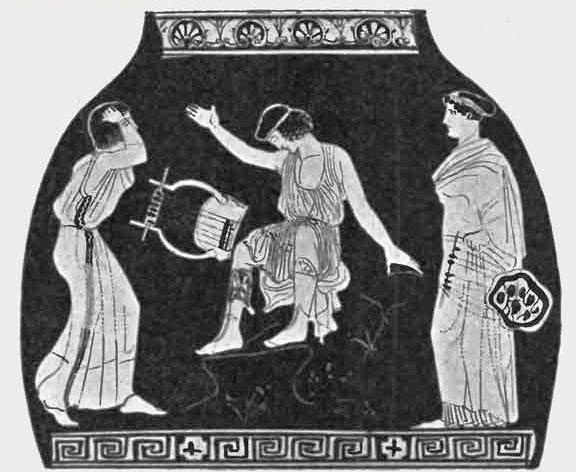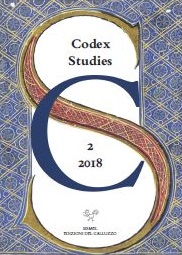| Collection | No. Docs. | Links |
| Abrégé de l'histoire ecclésiastique de M. l'abbé Fleury (1750) | 8 | Open the Collection. |
| Acta Martyrum et sanctorum [Bedjan Ed.]. | 6 | Open the Collection. |
| Acta Sanctorum. 1863. | 65 | Open the Collection. |
| Analecta Bollandiana. 1882-1908. | 27 | Open the Collection. |
| Aramaic related materials. | 27 | Open the Collection. |
| Archives d'histoire doctrinale et littéraire du Moyen-âge. 1926-1939. | 12 | Open the Collection. |
| Auger. Homélies, discours et lettres choisis de S. Jean Chrysostôme. 1826. | 4 | Open the Collection. |
| Aurelius Augustinus Hipponensis: Opera et Studia | 56 | Open the Collection. |
| Aurelius Augustinus. Opera Omnia [Des. Eras. Rot. Ed.]. 1528-1529. | 20 | Open the Collection. |
| Baer. Textum Masoreticum accuratissime expressit e fontibus Masorea varie illustravit. 1869. | 13 | Open the Collection. |
| Bibliothèque choisie des Pères de l'Église grecque et latine, ou, Cours d'éloquence sacrée [1822-1829]. | 26 | Open the Collection. |
| Brooke, McLean, Thackeray. The Old Testament in Greek according to the text of Codex vaticanus. 1906. | 8 | Open the Collection. |
| Bunsen. Christianity and mankind : their beginnings and prospects. 1854. | 7 | Open the Collection. |
| Byzantine Empire | 31 | Open the Collection. |
| Caillau. Thesaurus Patrum Floresque Doctorum. | 9 | Open the Collection. |
| Ceillier. Histoire générale des auteurs sacrés et ecclésiastiques [Nouvelle Édition].1858. | 17 | Open the Collection. |
| Ceillier. Histoire générale des auteurs sacrés et ecclésiastiques. 1729. | 23 | Open the Collection. |
| Church history | 78 | Open the Collection. |
| Clavis, Indices, Catalogi. | 6 | Open the Collection. |
| Clemens Alexandrinus. Opera [Dindorf Ed.]. 1869. | 4 | Open the Collection. |
| Clemens Alexandrinus: Opera et Studia | 14 | Open the Collection. |
| Codices, Incunabula & Early Editions | 52 | Open the Collection. |
| Collectio Selecta SS. Ecclesiæ Patrum. [Caillau, Guillon, Ed.]. | 4 | Open the Collection. |
| Corpus Inscriptionum Graecarum. 1828-1877. | 13 | Open the Collection. |
| Corpus Scriptorum Ecclesiasticorum Latinorum | 65 | Open the Collection. |
| Corpus Scriptorum Historiae Byzantinae | 51 | Open the Collection. |
| Cramer. Catenae Graecorum patrum in Novum Testamentum. 1844. | 8 | Open the Collection. |
| CSCO | 40 | Open the Collection. |
| Cyrillus Alexandrinus: : Opera et Studia. | 12 | Open the Collection. |
| Dictionaries, Lexicons, Grammars | 111 | Open the Collection. |
| Dictionnaire de la Bible (1912) | 12 | Open the Collection. |
| Dods. The works of Aurelius Augustine : a new translation. 1871. | 15 | Open the Collection. |
| Dufourcq. Étude sur les Gesta martyrum romains. 1900. | 4 | Open the Collection. |
| Eusebius Sophronius Hieronymus: Opera et Studia. | 11 | Open the Collection. |
| Exposition du dogme catholique (1873-1890). | 21 | Open the Collection. |
| External materials | 31 | Open the Collection. |
| Gfrörer. Pabst Gregorius VII und sein Zeitalter. 1859. | 10 | Open the Collection. |
| Gifford. Eusebiou tou pamphilou euaggelikes proparaskeues. 1903. | 5 | Open the Collection. |
| Giles. Saint Bede, The Complete Works of Venerable Bede, 8 vols. 1843. | 8 | Open the Collection. |
| Giry, Guérin. Les petits Bollandistes. 1888. | 17 | Open the Collection. |
| Greek ecclesiastical historians of the first six centuries of the Christian era. 1843. | 12 | Open the Collection. |
| Griechische Christliche Schriftsteller | 47 | Open the Collection. |
| Histoire des conciles d'après les documents originaux | 21 | Open the Collection. |
| Histoire des conciles d'après les documents originaux [1869]. | 12 | Open the Collection. |
| Histoire littéraire de l'Afrique chrétienne depuis les origines jusqu'à l'invasion arabe [1901]. | 6 | Open the Collection. |
| Individual Works, Studies, Monographies | 507 | Open the Collection. |
| Jeannin. Saint Jean Chrysostome. OEuvres Complètes. 1887. | 11 | Open the Collection. |
| Joannes Chrysostomus. Opera Omnia Quæ Exstant [Montfaucon, Ed.]. 1839. | 12 | Open the Collection. |
| Jstor Patristic/Patrological contents before 1923 year. | 3 | Open the Collection. |
| Klostermann. Eusebius Werke [GCS Ed.]. 1902. | 9 | Open the Collection. |
| Koetschau. Origenes Werke [GCS Ed.]. 1899. | 7 | Open the Collection. |
| La Sainte Bible Polyglotte (1900) | 9 | Open the Collection. |
| Lightfoot. The Apostolic Fathers : a revised text with introductions, notes, dissertations, and translations. 1890. | 5 | Open the Collection. |
| Luchaire. Innocent III. 1906-1908. | 6 | Open the Collection. |
| Mai. Patrum Nova Bibliotheca. 1843-1854. | 8 | Open the Collection. |
| Mai. Spicilegium romanum. 1839. | 10 | Open the Collection. |
| Mémoires pour servir a l'histoire écclésiastique. | 16 | Open the Collection. |
| Migne. Patrologiae Cursus Completus, Series Latina. [PIMS Digitazion]. | 220 | Open the Collection. |
| Miscellanea | 129 | Open the Collection. |
| Montalembert. Les moines d'Occident depuis Saint Benoít jusqu'a Saint Bernard/The monks of the West, from St. Benedict to St. Bernard | 14 | Open the Collection. |
| Moroni. Dizionario di erudizione storico-ecclesiastica da S. Pietro sino ai nostri giorni. 1840. | 109 | Open the Collection. |
| Mourret. Histoire générale de l'Église. 1921. | 9 | Open the Collection. |
| Opera Spuria, Apocrypha, Gnostica seu Haeretica. | 50 | Open the Collection. |
| Origen. Opera omnia quae graece vel latine tantum exstant [La Rue, Lommatzsch Eds.]. 1831. | 25 | Open the Collection. |
| Patres Quarti Ecclesiæ Sæculi: Ambrosius. Opera Omnia. [Caillau, Guillon Ed.]. 1836. | 10 | Open the Collection. |
| Patres Quarti Ecclesiæ Sæculi: Basilius. Opera Omnia. [Caillau, Guillon Ed.]. 1833. | 5 | Open the Collection. |
| Patres Quarti Ecclesiæ Sæculi: Eusebius. Opera Omnia. [Caillau, Guillon Ed.]. 1830. | 6 | Open the Collection. |
| Patres Quarti Ecclesiæ Sæculi: Gregorius Theologus. Opera Omnia. [Caillau, Guillon Ed.]. 1835. | 5 | Open the Collection. |
| Patres Quarti Ecclesiæ Sæculi: S. Athanasius. Opera Omnia. [Caillau, Guillon Ed.]. 1830. | 4 | Open the Collection. |
| Patres Quarti Ecclesiæ Sæculi: S. Ephræm. Opera Omnia. [Caillau, Guillon Ed.]. 1832. | 8 | Open the Collection. |
| Patres Quinti Ecclesiaæ Sæculi: S. Augustinus. Opera Omnia. [Caillau, Guillon Ed.]. 1835. | 41 | Open the Collection. |
| Patres Quinti Ecclesiæ Sæculi: Joannes Chrysostomus. Opera Omnia. [Caillau, Guillon Ed.]. 1835. | 26 | Open the Collection. |
| Patres Tertii Ecclesiæ Sæculi: Origenes. Opera Omnia. [Caillau, Guillon Ed.]. 1829. | 7 | Open the Collection. |
| Patrologia Graeca [Googlebooks]. | 307 | Open the Collection. |
| Patrologia Graeca [Internet Archive]. | 16 | Open the Collection. |
| Patrologia Latina [BNF/Gallica]. | 181 | Open the Collection. |
| Patrologia Latina [Googlebooks]. | 286 | Open the Collection. |
| Patrologia Orientalis [BNF/Gallica Digitazion]. | 35 | Open the Collection. |
| Patrologia Orientalis [PIMS Digitazion]. | 16 | Open the Collection. |
| Patrologia Orientalis [University of Toronto Digitazion]. | 24 | Open the Collection. |
| Patrologia Orientalis [University of Toronto Digitazion]. | 24 | Open the Collection. |
| Philo of Alexandria. Opera Omnia. 1828. | 8 | Open the Collection. |
| Poujoulat, Raulx. Saint Augustin. OEuvres Complètes. 1864. | 13 | Open the Collection. |
| Poujoulat. Lettres de Saint Augustin. 1858. | 4 | Open the Collection. |
| Res aliena | 512 | Open the Collection. |
| Res aliena: Iudaica. | 90 | Open the Collection. |
| Res Curiosa & Rara. | 4 | Open the Collection. |
| Revue de l'Orient Chrétien | 30 | Open the Collection. |
| Revue de l'Orient Latin | 9 | Open the Collection. |
| Revue des études byzantines. 1943-2005. | 244 | Open the Collection. |
| Riches de Levante. The hexaglot Bible : comprising the Holy Scriptures of the Old and New Testaments in the original tongues. 1906. | 6 | Open the Collection. |
| Roberts, Donaldson. Ante-Nicene Christian library : translations of the writings of the Fathers down to A. D. 325. 1867. | 24 | Open the Collection. |
| Robinson. Texts and studies : contributions to Biblical and Patristic literature. 1891. | 14 | Open the Collection. |
| Rohrbacher, Dufour. Histoire universelle de l'Église Catholique. 1842-1849. | 30 | Open the Collection. |
| Routh. Reliquiae sacrae. 1846. | 5 | Open the Collection. |
| S. Isidorus Hispalensis. Opera Omnia. [Franciscus Lorenzana Ed.]. 1797. | 7 | Open the Collection. |
| S. P. C. K. | 24 | Open the Collection. |
| Sacra Scriptura | 161 | Open the Collection. |
| Sacrorum conciliorum nova et amplissima collectio [H. Welter, Ed. 1901-1927] | 14 | Open the Collection. |
| Saint Basil. Opera omnia quae exstant [Julianus Garnier Ed.]. 1839. | 6 | Open the Collection. |
| Saint Bernard. Oeuvres Complètes [Charpentier, Trad.]. 1865. | 7 | Open the Collection. |
| Schaff, Wace. A Select library of Nicene and post-Nicene fathers of the Christian church. Second series. 1890-1900. | 14 | Open the Collection. |
| Schaff. A Select library of the Nicene and post-Nicene fathers of the Christian church. First series. 1886. | 14 | Open the Collection. |
| Scriptorum Veterum Nova Collectio | 10 | Open the Collection. |
| Sevestre. Dictionnaire de Patrologie. 1851. | 4 | Open the Collection. |
| Sic vos, non vobis | 2 | Open the Collection. |
| SMSR | 41 | Open the Collection. |
| Texte und Untersuchungen zur Geschichte der altchristlichen Literatur. 1883. | 41 | Open the Collection. |
| The Fathers of the Church | 31 | Open the Collection. |
| The history of the popes, from the close of the middle ages | 40 | Open the Collection. |
| Tischendorf. Novum Testamentum graece. 1869. | 7 | Open the Collection. |
| Vivien. Tertullianus praedicans. 1856. | 6 | Open the Collection. |
| Whiston. Primitive Christianity reviv'd : in four volumes. 1711. | 4 | Open the Collection. |
| XXXIII. | 33 | Open the Collection. |































